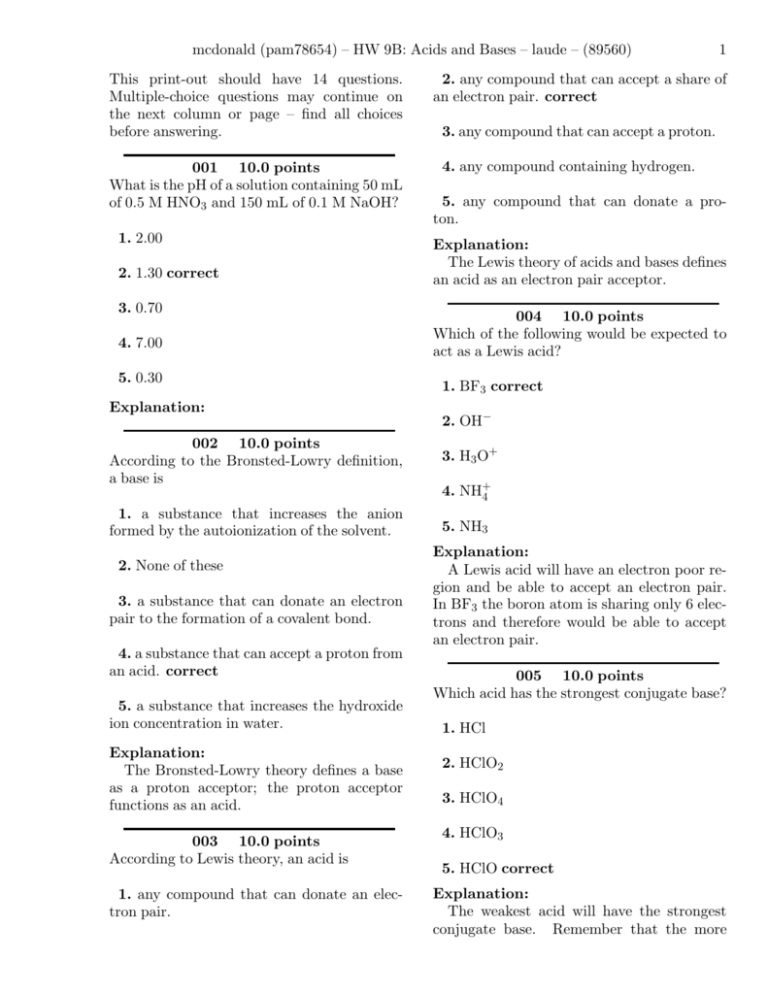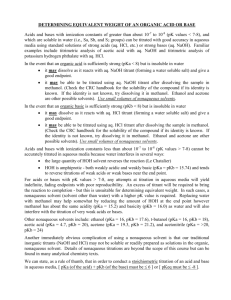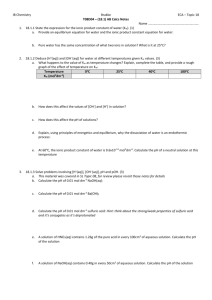Worksheet 9B on Acids and Bases
advertisement

mcdonald (pam78654) – HW 9B: Acids and Bases – laude – (89560) This print-out should have 14 questions. Multiple-choice questions may continue on the next column or page – find all choices before answering. 001 10.0 points What is the pH of a solution containing 50 mL of 0.5 M HNO3 and 150 mL of 0.1 M NaOH? 1. 2.00 2. 1.30 correct 3. 0.70 4. 7.00 5. 0.30 Explanation: 002 10.0 points According to the Bronsted-Lowry definition, a base is 1. a substance that increases the anion formed by the autoionization of the solvent. 2. None of these 3. a substance that can donate an electron pair to the formation of a covalent bond. 4. a substance that can accept a proton from an acid. correct 5. a substance that increases the hydroxide ion concentration in water. Explanation: The Bronsted-Lowry theory defines a base as a proton acceptor; the proton acceptor functions as an acid. 003 10.0 points According to Lewis theory, an acid is 1. any compound that can donate an electron pair. 1 2. any compound that can accept a share of an electron pair. correct 3. any compound that can accept a proton. 4. any compound containing hydrogen. 5. any compound that can donate a proton. Explanation: The Lewis theory of acids and bases defines an acid as an electron pair acceptor. 004 10.0 points Which of the following would be expected to act as a Lewis acid? 1. BF3 correct 2. OH− 3. H3 O+ 4. NH+ 4 5. NH3 Explanation: A Lewis acid will have an electron poor region and be able to accept an electron pair. In BF3 the boron atom is sharing only 6 electrons and therefore would be able to accept an electron pair. 005 10.0 points Which acid has the strongest conjugate base? 1. HCl 2. HClO2 3. HClO4 4. HClO3 5. HClO correct Explanation: The weakest acid will have the strongest conjugate base. Remember that the more mcdonald (pam78654) – HW 9B: Acids and Bases – laude – (89560) oxyzen atoms that surround an acid, the stronger it becomes. This means that HClO is the weakest acid listed above, so it will have the strongest conjugate base. 006 10.0 points You have a weak molecular base with Kb = 6.6 × 10−9 . What is the pH of a 0.0500 M solution of this weak base? 2 an eye wash. What is the approximate pH of this solution? For boric acid Ka = 7.2×10−10 . 1. pH = 5 correct 2. pH = 7 3. pH = 3 4. pH = 4 1. pH = 9.26 correct 5. pH = 6 2. pH = 3.63 Explanation: 3. pH = 7.12 4. None of these 5. pH = 4.74 Explanation: [base] = 0.05 M As mentioned, this is a weak base, so use the equation to calculate weak base [OH− ] concentration: p [OH− ] = Kb Cb q = (6.6 × 10−9 ) (0.05) = 1.81659 × 10−5 After finding [OH− ], you can find pH using either method below: A) pOH = − log 1.81659 × 10−5 = 4.74074 pH = 14 − 4.74074 = 9.25926 or B) Kw = [H+ ][OH− ] = 1 × 10−14 Kw [H+ ] = [OH− ] 1 × 10−14 = 5.50482 × 10−10 = 1.81659 × 10−5 pH = − log 5.50482 × 10−10 = 9.25926 007 10.0 points A solution of 0.2 M boric acid is prepared as 008 10.0 points Of the four compounds HF, HClO2 , NaOH, Ba(OH)2 which are either strong acids or strong bases in water? 1. All are either strong acids or strong bases. 2. NaOH 3. None are strong acids nor strong bases. 4. HClO2 and NaOH 5. NaOH and Ba(OH)2 correct Explanation: Memorize the strong acids and strong bases. All others are weak. Only NaOH and Ba(OH)2 are strong; they are strong bases. 009 10.0 points What is the pH of a solution containing 0.3 M NH4 Cl and 0.6 M NH3 ? The pKa of the ammonium ion is 9.25. 1. 9.55 correct 2. 8.95 3. 12.25 4. 5.05 mcdonald (pam78654) – HW 9B: Acids and Bases – laude – (89560) 5. 4.45 The pOH at point I is equal to the the pH at point II is pH 7. Explanation: For NH+ 4 , pKa = 9.25 pKb = pKw − pKa = 14 − 9.25 = 4.75 3 and 1. pKb of the base, less than correct 2. pH of the base, less than pKb = − log Kb Kb = 10−pKb = 10−4.75 = 1.77828 × 10−5 3. pKb of the base, equal to 4. pKb of the base, greater than Building an ICE using molarities, 5. pH of the base, greater than − NH+ 4 (aq)+OH (aq) NH3(aq)+H2 O(ℓ)⇀ ↽ 0.6 −x +x 0.6 − x 0.3 + x +x +x − [NH+ (0.3 + x) x 0.3 x 4 ] [OH ] = ≈ [NH3] 0.6 − x 0.6 0.6 (1.77828 × 10−5 ) 0.6 Kb = x= 0.3 0.3 = 3.55656 × 10−5 = [OH− ] Kb = Kw 1 × 10−14 [H ] = = [OH− ] 3.55656 × 10−5 = 2.81171 × 10−10 + Thus Explanation: 011 10.0 points Which equation represents Ka2 for phosphoric acid? 1. HPO2− 4 (aq) + H2 O(ℓ) → + PO3− 4 (aq) + H3 O (aq) 2. H2 PO− 4 (aq) + H2 O(ℓ) → + HPO2− 4 (aq) + H3 O (aq) correct 3. H3 PO4 (aq) + 2 H2O(ℓ) → + HPO2− 4 (aq) + 2 H3 O (aq) pH = − log(2.81171 × 10−10 ) = 9.55103 4. H3 PO4 (aq) + H2 O(ℓ) → + H2 PO− 4 (aq) + H3 O (aq) 010 10.0 points Consider the titration curve of a weak base with a strong acid 5. HPO2− 4 (aq) + H2 O(ℓ) → − H2 PO− 4 (aq) + OH (aq) Explanation: b I pH II b 012 10.0 points The pH of 0.010 M H3 PO4 (aq) is 2.24. Estimate the concentration of HPO2− 4 in the solution. For H3 PO4 , the values of Ka1 , Ka2 , and Ka3 are 7.6×10−3 , 6.2×10−8 , and 2.1×10−13 , respectively. Volume of acid added 1. 6.2 × 10−8 M correct mcdonald (pam78654) – HW 9B: Acids and Bases – laude – (89560) 4 Thus we have 2. 5.8 × 10 −3 M 3. 2.1 × 10 −13 N2 H4 (pKb (weakest) BrO− (pKb CN− (pKb (C2 H5 )3 N (pKb (strongest) M 4. 0.010 M 5. 7.6 × 10−3 M 014 Explanation: 013 10.0 points List the bases CN− , (C2 H5 )3 N, N2 H4 , BrO− in order of decreasing strength, if = 5.77) = 14.0 − 8.69 = 5.31) = 14.0 − 9.31 = 4.69) = 2.99) 10.0 points What would be the pH of a solution prepared from 2 L of 0.05 M HClO and 1 L of 3.16 M NaClO? The Ka of chlorous acid is 3.16 × 10−8 . 1. 6 Base pKb (C2 H5 )3 N 2.99 N2 H4 5.77 Acid pKa HBrO 8.69 HCN 9.31 2. 7.5 3. 9 correct 4. 9.3 1. CN− , N2 H4 , BrO− , (C2 H5 )3 N 2. (C2 H5 )3 N, BrO− , N2 H4 , CN− 3. N2 H4 , BrO− , CN− , (C2 H5 )3 N 4. (C2 H5 )3 N, CN− , BrO− , N2 H4 correct 5. (C2 H5 )3 N, BrO− , CN− , N2 H4 6. BrO− , (C2 H5 )3 N, N2 H4 , CN− 7. None of these 8. CN− , N2 H4 , (C2 H5 )3 N, BrO− 9. N2 H4 , CN− , BrO− , (C2 H5 )3 N Explanation: The stronger the base, the larger its Kb value and the smaller its pKb value from pKb = − log Kb . To find the pKb for the conjugate base of a weak acid, use pKa + pKb = 14. Explanation: Because this is a buffer, it is acceptable to use moles in place of concentrations [H+ ] = Ka (Ca /Cb ) = 3.16 × 10−8 (0.1 M/3.16 M) = 1 × 10−9 pH = 9









